George Frederick Bristow: Symphony No. 4 in e minor, Op. 50, “Arcadian” (1872) – Second Movement: Andante religioso, “Halt on the Prairie” – An Analysis by Kyle Gann
Comments Off on George Frederick Bristow: Symphony No. 4 in e minor, Op. 50, “Arcadian” (1872) – Second Movement: Andante religioso, “Halt on the Prairie” – An Analysis by Kyle GannSeptember 15, 2019 by Admin

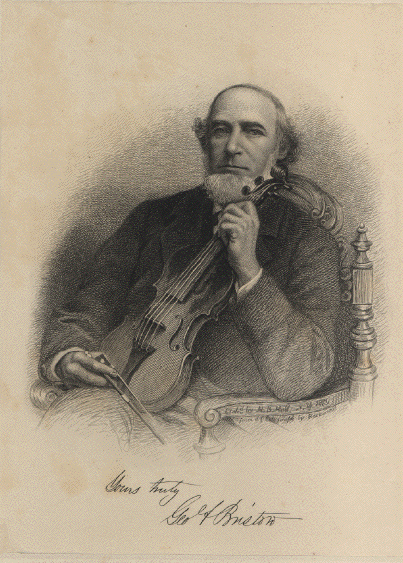 Analysis by Kyle Gann
Analysis by Kyle Gann
All score reductions by the author.
The second movement Adagio contains some of the symphony’s finest moments. It, too, is in sonata form, but the development section is so brief and so smoothly continued from the exposition as to suggest the common “Sonata without development” slow-movement form. In each half the first thematic area is in 4/4 meter and the second in 12/8. The following chart correlates the measures in the exposition with the parallel passages in the recapitulation.
| 4/4 meter | ||
| Exposition | Recapitulation | |
| mm. 1-16 | Theme A | mm. 70-85 |
| mm. 17-24 | Chorale theme | mm. 86-93 |
| 12/8 meter | ||
| mm. 25-30 | Bridge melody | mm. 94-99 |
| mm. 31-35 | Transition | mm. 100-104 |
| mm. 36-47 in G | Theme D | mm. 105-116 in B |
| mm. 48-69 | Different material | mm. 117-125 |
| 4/4 meter | ||
| Coda, mm. 125-136 |
The first thematic area divides into two parts. The first has half the melody in the horn and the second half in the strings. Notice the peculiar F-double-sharp in mm. 6-8: it remains rather enigmatic here, but in the recapitulation the strings will pick up that F-double-sharp (instead of F# as here) as part of a D# dominant seventh resolving to G# minor, but the original melody is quickly resumed, though in the winds rather than in the strings. This peculiar moment of stasis on a D# major triad seems to be setting the stage for something, and I think it does.
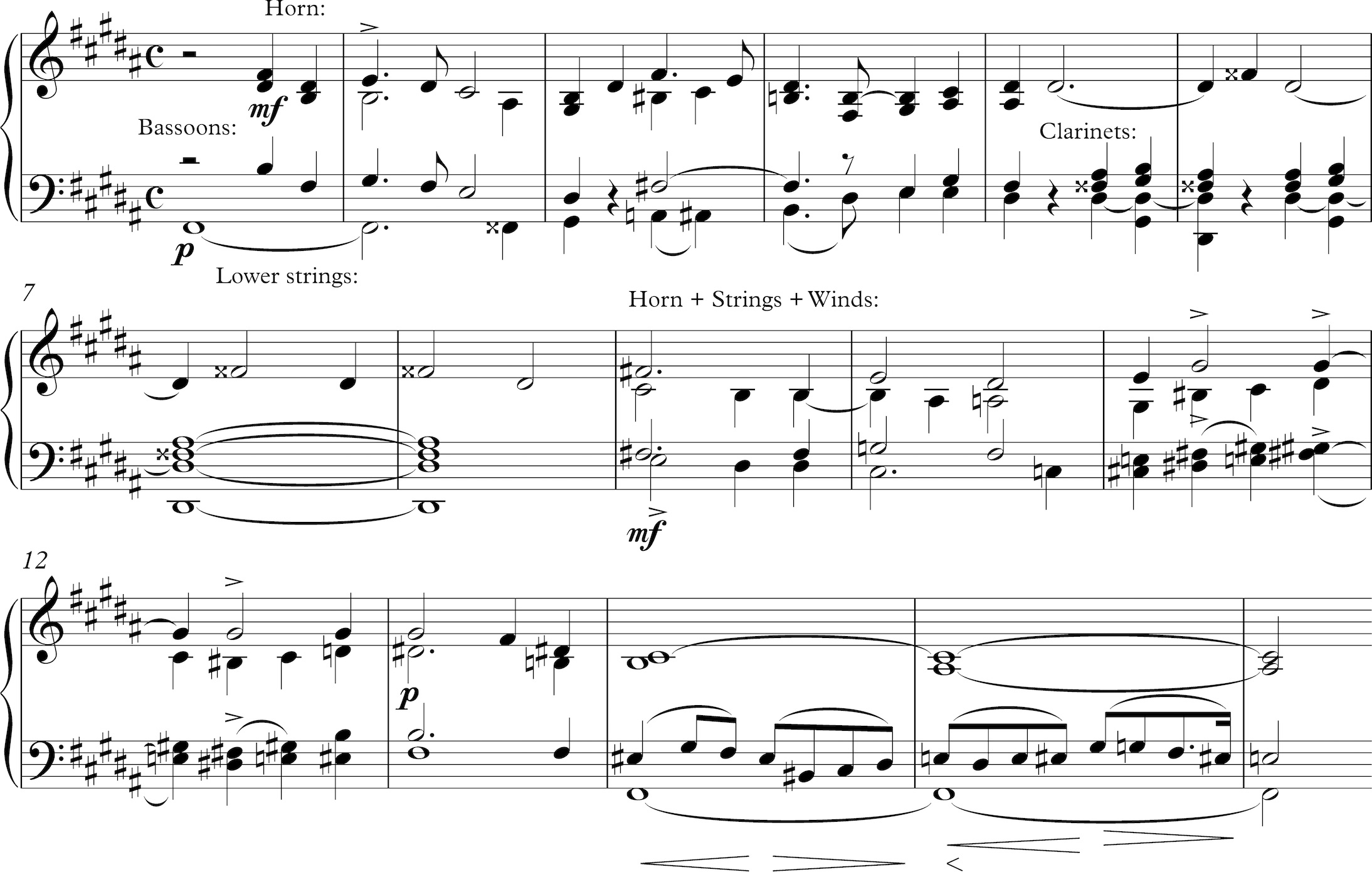
After a drawn-out half cadence, the lower brass play “Tallis’s Evening Hymn” (“All praise to Thee, my God, this night”), a hymn based on an old tune by Thomas Tallis (1505-1585) that others later provided words for, and which was popular in 19th-century America. These brass players are clearly meant to represent the pioneers paused for the night on the prairie, singing a hymn before or after dinner as thanks for their safe journey so far. Bristow will later put the hymn’s elements to good use.
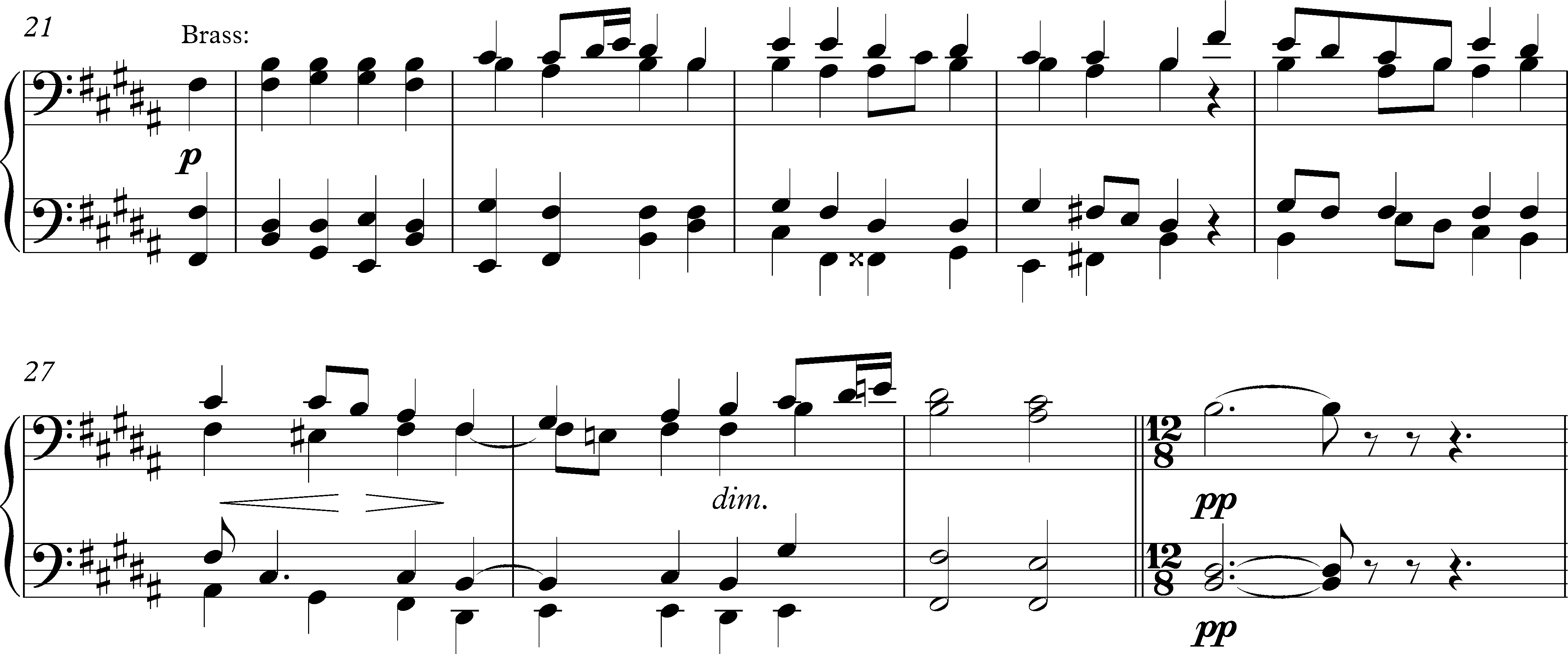
The melody that opens the section in 12/8 has the valedictory flavor of a closing theme, but it is brief, and soon leads into an orchestral climax that will effect the key change.
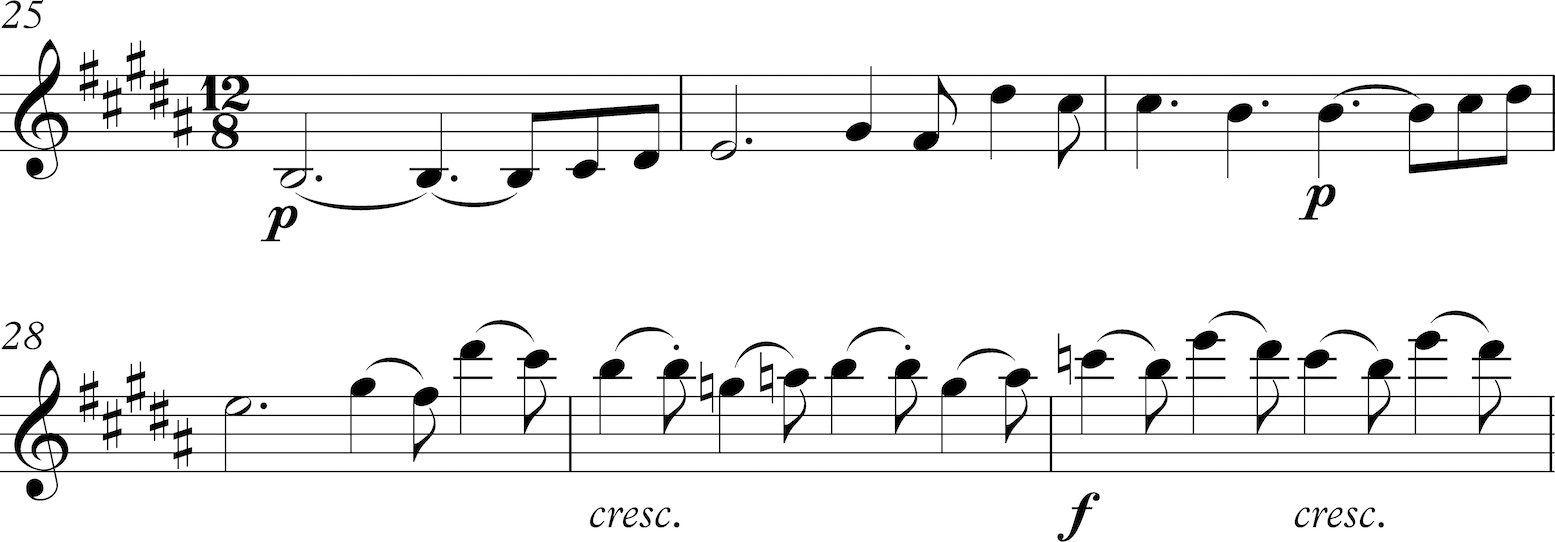
This melody quickly (at m. 31) leads to an F-natural dominant seventh, which changes course into C major, then a diminished seventh on C# leading to an apparent Eb dominant which is actually a German sixth chord in the key of G – which is how it resolves, into the movement’s real second theme in the subordinate key of G (and subordinate key for the first and fourth movements as well). For comparison I also show the return of this passage in the recapitulation, where instead it goes into E major and then a G dominant seventh, which is actually the (misspelled) German sixth of B; this is how Bristow returns his second theme to the tonic the second time around. This use of reversed dominant sevenths and German sixths, from B to Eb7 to G and from B to G7 to B, is quite familiar to any student of the music of Schubert, Brahms, and other Romantics. I make this rather boring technical point merely to emphasize how comfortable Bristow was using the same tricks of the trade as his European contemporaries.
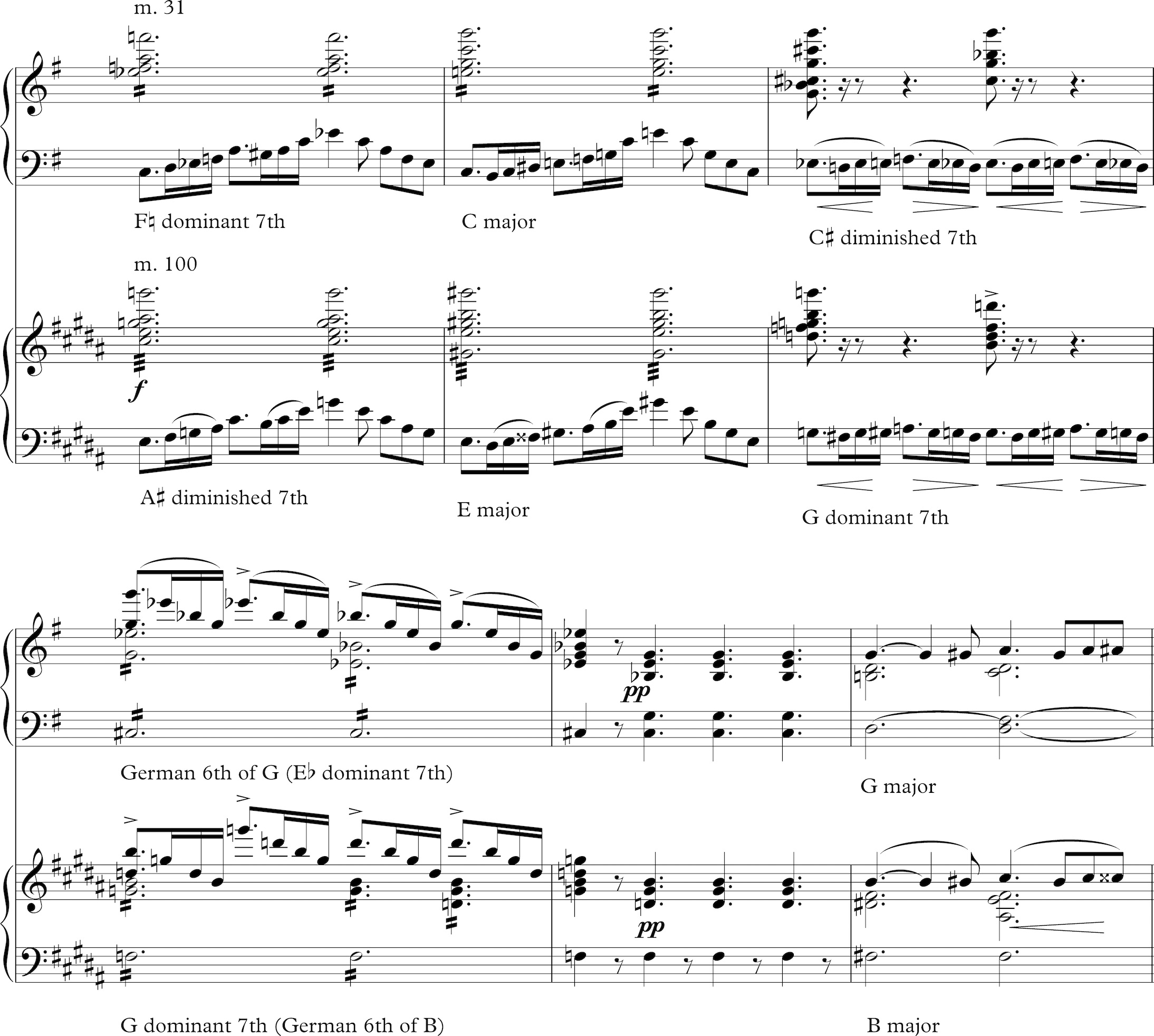
The languid subordinate theme follows (m. 36), delightfully dotted with staccato woodwind chords on the off-beats. Notice the leap up from G to E and Eb in m. 38; he repeats it at m. 42 only leaping up to B and Bb as a way to turn the theme toward the dominant key. Notice in mm. 37-38 that B-C and F#-G are the paired half-steps this melody is based on.
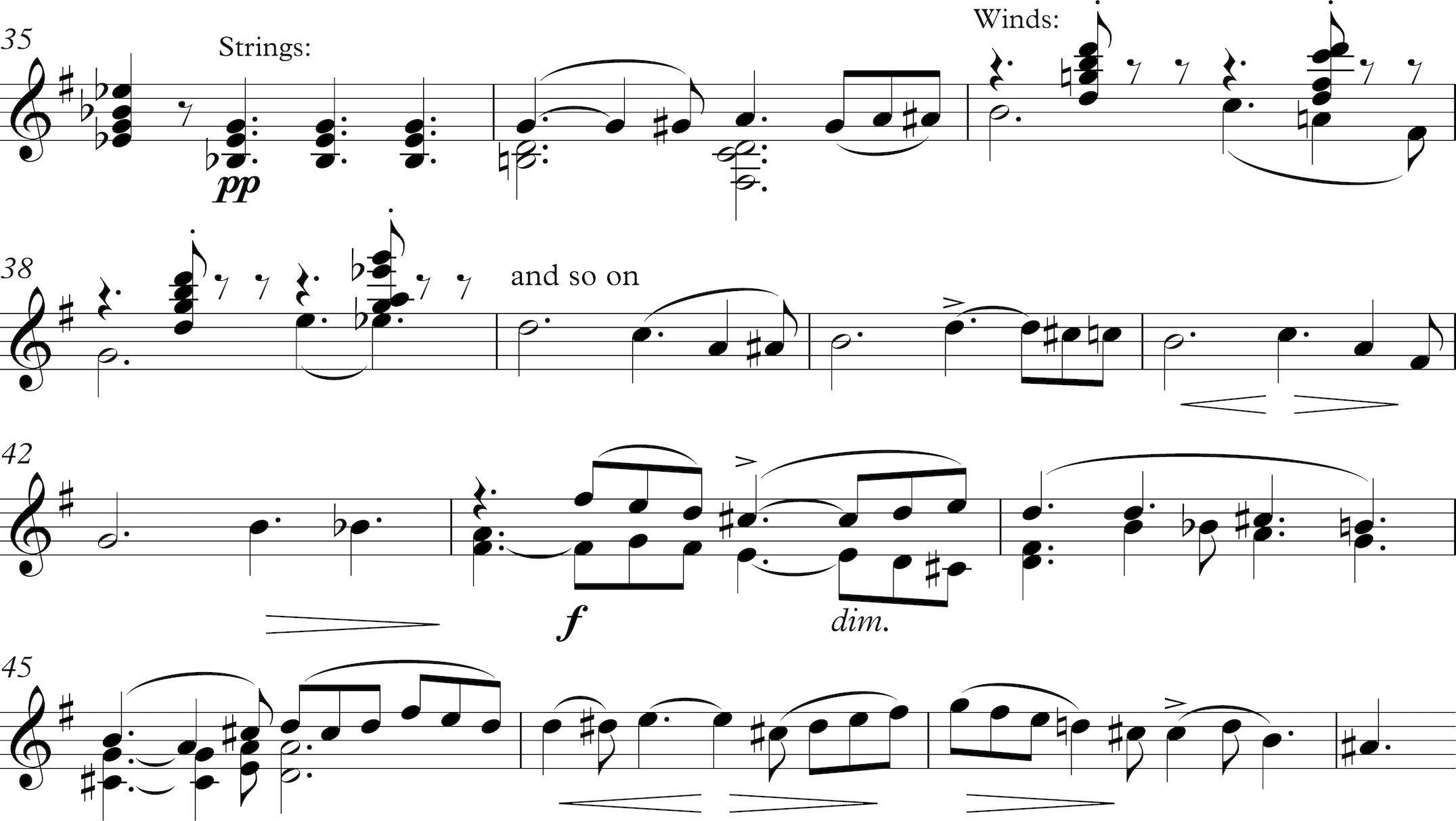
In mm. 45-47 the music modulates to the dominant D’s relative minor B, and the subordinate theme is played in the dominant of that key, F# (mm. 48-51). Nevertheless, a following A dominant seventh brings the music back to G major, and another modulation (mm. 58-59) brings the harmony back to B major. In what seems a common orchestral platitude at first, the orchestra pounds on a unison B – which, in retrospect, turns out to be the beginning of the chorale theme from the first section, its second phrase now clothed in a meltingly nostalgic harmonic sequence through the circle of fifths. It’s clever that the stolid tune that opened the chorale now doubles as a cadential gesture. The motive is then repeated on F#, as dominant preparation for the recapitulation.
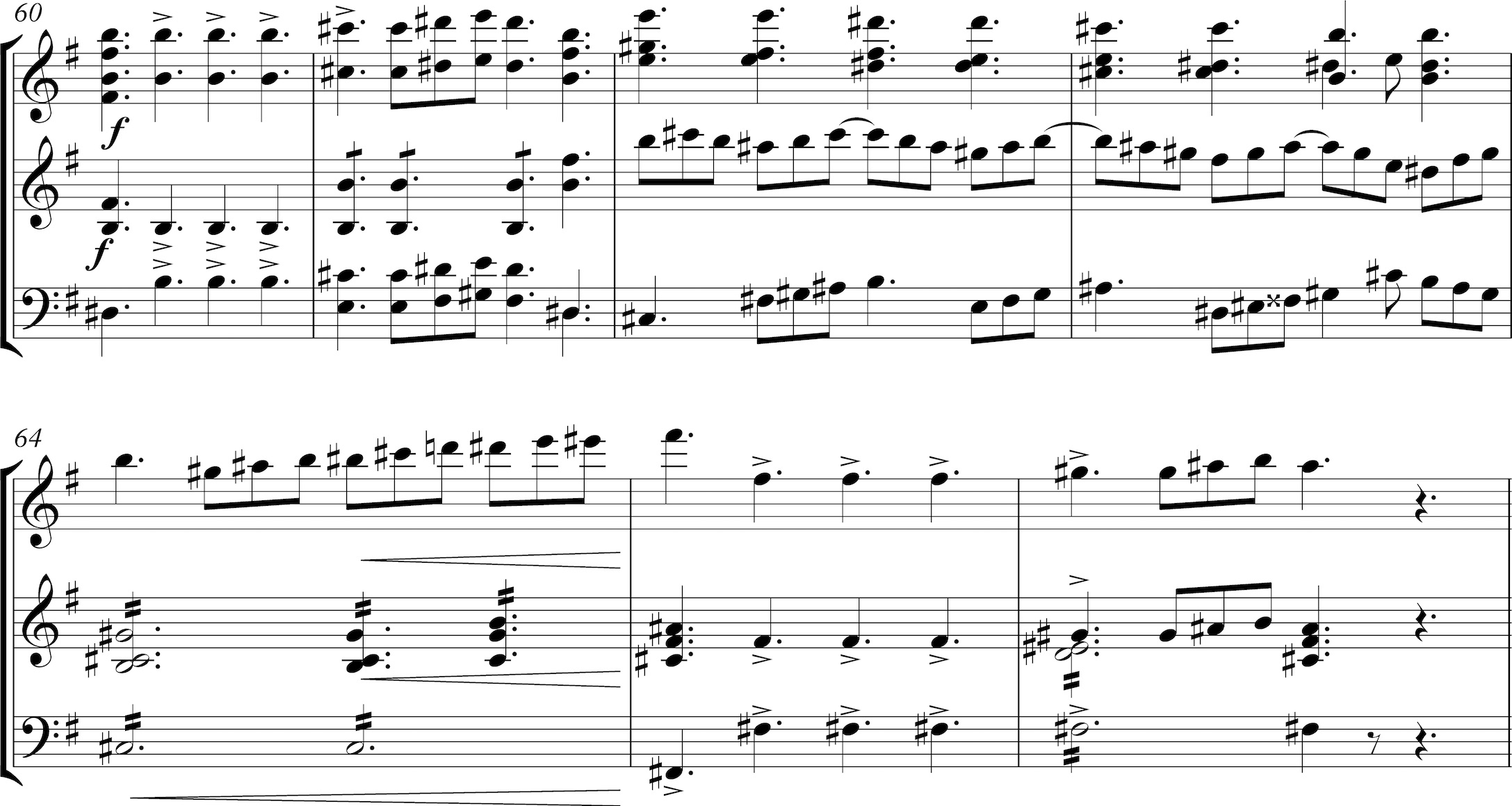
A quiet repetition of this phrase (mm. 67-69) brings the music to a dominant of B major.
The recap’s first theme is almost verbatim taken over from the exposition, though with one harmonic deviation already noted and some changes in instrumentation. It is the new version of the chorale melody that is perhaps this movement’s happiest feature. Once again the tune is played by the horn, but instead of an ascetic chorale setting, now the strings provide a cheery pizzicato accompaniment, while the first violins whirl away overhead in athletic triplet 16th-notes. The atmosphere could not be more transformed – it is as though the ascetic hymn came back accompanied by fireworks and fireflies.
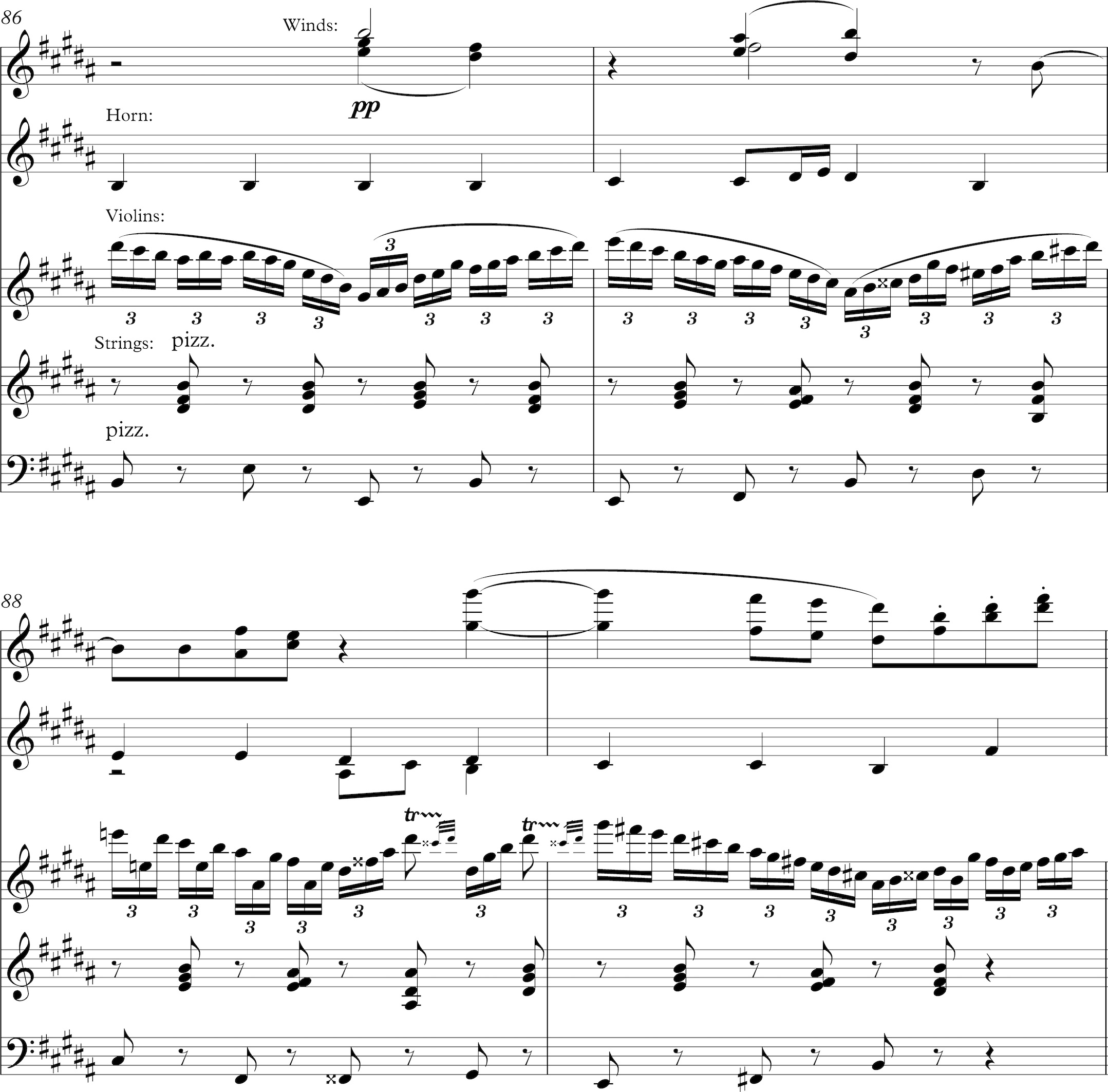
The 12/8 section in the recapitulation follows its partner in the exposition very closely up until the modulation that prepares to state the subordinate theme in the tonic key, shown above. Not until m. 117 does the recapitulation depart from earlier material, spinning motives from the subordinate melody for an eight-measure close. Interestingly, its climax once again uses the F-double-sharp to rise to a G# minor triad, as had happened at m. 78. The quiet coda, lasting eleven measures, is a chorale in the clarinets and bassoons over an ostinato of alternating B’s and A#’s in the lower strings – quite reminiscent of passages in the first movement in which the bass alternated between B and C.
Hear George Frederick Bristow’s Symphony No. 4 in e minor, Op. 50, “Arcadian” below.
Read about George Frederick Bristow here.
 Kyle Gann (b. 1955 in Dallas, Texas) is a composer and was new-music critic for the Village Voice from 1986 to 2005. Since 1997 he has taught at Bard College. He is the author of seven books on American music, including books on Conlon Nancarrow, Robert Ashley, John Cage’s 4’33”, and Charles Ives’s Concord Sonata. He studied composition with Ben Johnston, Morton Feldman, and Peter Gena, and much of his music is microtonal. His major works include the piano concerto Sunken City, Transcendental Sonnets for chorus and orchestra, the microtonal music theater piece Custer and Sitting Bull and The Planets for mixed octet. Visit him at http://www.kylegann.com/.
Kyle Gann (b. 1955 in Dallas, Texas) is a composer and was new-music critic for the Village Voice from 1986 to 2005. Since 1997 he has taught at Bard College. He is the author of seven books on American music, including books on Conlon Nancarrow, Robert Ashley, John Cage’s 4’33”, and Charles Ives’s Concord Sonata. He studied composition with Ben Johnston, Morton Feldman, and Peter Gena, and much of his music is microtonal. His major works include the piano concerto Sunken City, Transcendental Sonnets for chorus and orchestra, the microtonal music theater piece Custer and Sitting Bull and The Planets for mixed octet. Visit him at http://www.kylegann.com/.Category Sight, Sound, Word | Tags:
Comments Off on George Frederick Bristow: Symphony No. 4 in e minor, Op. 50, “Arcadian” (1872) – Second Movement: Andante religioso, “Halt on the Prairie” – An Analysis by Kyle Gann
Sorry, comments are closed.

